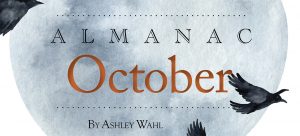
The Last Ride
A legendary car, two old dogs and the end of the road in sight
By Jim Dodson
I knew this day would eventually come.
In recent years, I’ve pushed the thought to the back of my mind that it might be time to say goodbye and hand her off to someone who can restore her to her glory.
But every time I take her for a spin, by Jove, The Pearl works her automotive magic on me, riding like a dream, cruising the world on eight cylinders and a Corvette engine. With her roomy leather seats and patented “Dynaride” suspension system, she’s still like driving in your living room. We’ve been together a dozen years, almost half The Pearl’s life and almost one-sixth of mine. We survived the Great Recession, the end of cassette players and four teenagers. My dog Mulligan has spent most of her long life riding shotgun in The Pearl. Oh, the places we’ve been together up and down the highway!
The Pearl is a 1996 Buick Roadmaster estate station wagon, reportedly the last true production wagon that General Motors made before switching to prissy little SUVs.
The mighty Roadmaster is an American automotive icon, introduced in 1936 as the nation began to crawl out from under the Great Depression. Its creators had this nutty idea that Americans getting back on their feet might want to take the family on a road trip to see the land of the free and the home of the brave. With its oversized windows, sleek lines, wide chassis, faux wooden siding, “vista roof” and proverbial third seat facing backwards, the versatile Roadmaster wagon was just the ticket for seeing America from ground level.
The end of the Roadmaster line came in 1996 when 22,989 models rolled off the assembly line for the last time.
Mine entered the life of a nice gentleman from New Jersey who loved the car so much he kept the dashboard covered with protective felt and put only 60,000 miles on its odometer over 12 years.
Fate and quiet desperation brought us together when my children began stealing the Volvos and Subarus to go off to college. I wrote a newspaper column joking that I was shopping for a car like the one my old man drove when I was a kid — a gas-guzzling monster of the American highway that no enlightened, environmentally-minded Millennial would be caught dead riding in around town. It turns out, that car was a Buick Roadmaster wagon.
Not two days after the column appeared, a woman phoned to say, “Mr. Dodson, I am here to make you a happy man.”
Her father and mother were residents of a local senior living community. They owned a 1996 Buick Roadmaster station wagon that the daughter had fooled her father into giving up, lest he injure himself or someone else due to his declining driving habits.
“My father bought the car new and absolutely adores it,” she explained. “We all loved it. It took me off to college and helped me move several times. She has a few dings but still runs like a dream. But it has to go.”
She explained that a vintage car buff out West was interested in buying it — Roadmasters were apparently big with car collectors — but if I wanted to check it out at a local garage, she would consider selling it to me.
“If you don’t buy this car,” said the mechanic, handing me the keys for a test drive, “I probably will. They don’t make cars like this anymore.”
I purchased it an hour later. My wife laughed when she saw it pull into the driveway. “Oh my,” she said. “That really is your father’s Buick.”
No. 1 son — the Subaru thief — asked if he could take the car off to college. Not a chance, I told him.
No. 2 son pointed out that my Roadmaster model was ranked No. 7 on the “official list of Best Cars to Own in the Event of a Zombie Apocalypse.” He wondered if he could take it for a spin.
“Maybe after the zombie apocalypse,” I said.
I had, after all, my own big plans for this oversized jewel of the 20th Century American highway.
For many years — decades, actually — I’d dreamed of finding and traveling the Great Wagon Road of Colonial America, the famous backcountry highway that brought thousands of Scots-Irish, German and other European immigrants to the American South during the 18th century, including my own English and Scottish forebears.
Historians and old road experts had recently determined the Great Road’s original path from Philadelphia to Augusta, Georgia — an 850-mile land route that passed through some of the most historic battlefields, towns and sacred landscapes of early America.
Dan’l Boone and his family traveled it from Pennsylvania to the banks of the Yadkin River. The most pivotal battles of the Revolutionary War were fought along the highway, including engagements at Cowpens, Kings Mountain and Guilford Courthouse, leading to the British surrender at Yorktown.
America’s first immigrant highway also bisected the killing fields of the American Civil War at Antietam and Gettysburg, where Abraham Lincoln — whose grandfather lived on the Great Road in Virginia — gave the Gettysburg Address on a hill just above the highway. By my count, in fact, no less than seven U.S. presidents were either born directly on or traveled the Great Wagon Road most of their lives. The Scots-Irish brought their balladry, fiddle music and God-given talent for fighting (and making corn whiskey) down the road, giving birth to Bluegrass in the hollers of Appalachia.
Four summers ago, after years of research and planning, my dog Mulligan and I set off along the road in our own Great Wagon, which a colleague at work nicknamed The Pearl, hoping to travel the entire route in two or three weeks.
Silly me. It took a month just to get out of Pennsylvania. The abundance of great stories and memorable people we met along the road turned an 800-mile road trip into a three-year, 3,000-mile odyssey of discovery that recently drew to a close, including a year of travel lost due to COVID.
Though she is showing her age and is more dinged up than ever, The Pearl managed to make the entire journey and then some. She brought us home with an engine that still runs like a dream.
Along the way, she provided absolute strangers with fond memories of their own childhood. “My father had a car just like that,” they would say with a note of pure wonder. “It was my favorite family car.” A man in the parking lot at Gettysburg actually offered to buy The Pearl. “How much do you want for her?” he asked.
“Nothing,” I replied. “But I might someday give her to the right person.”
He handed me a card, which I promptly lost.
Since finishing the road last autumn, The Pearl has mostly been my gardening car, hauling shrubs and mulch, though Miss Mulligan and I go out for a spin every now and then.
Mully is now 16, The Pearl is pushing 25. The last ride can’t be far away.
But what a time we’ve had, what a sweet journey it’s been. OH
Jim Dodson is O.Henry’s founding editor and ambassador-at-large.





